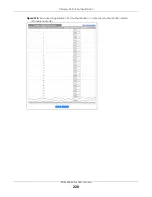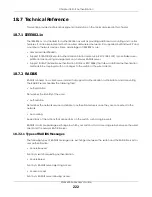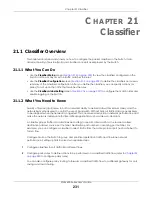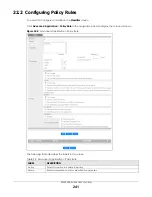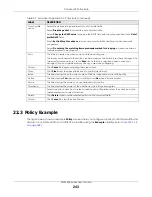
Chapter 21 Classifier
XGS4600 Series User’s Guide
234
The following table describes the labels in this screen.
Table 87 Advanced Application > Classifier > Classifier Configuration
LABEL
DESCRIPTION
Active
Select this option to enable this rule.
Name
Enter a descriptive name for this rule for identifying purposes.
Weight
Enter a number between 0 and 65535 to specify the rule’s weight. When the match order is in manual
mode in the
Classifier Global Setting
screen, a higher weight means a higher priority.
Log
Select this option to have the Switch create a log message when the rule is applied and record the
number of matched packets in a particular time interval.
Note: Make sure you also enable logging in the
Classifier Global Setting
screen.
Count
Select this option to have the Switch count how many times the rule is applied.
Time
Range
Select the name of the pre-configured schedule that you want to apply to the rule. The rule will be
active only at the scheduled date and/or time.
If you select
None
, the rule will be active all the time.
Ingress Port
Port
Type the port number to which the rule should be applied. You may choose one port only or all ports
(
Any
). Please note that the default stacking ports (the last two ports of your Switch) cannot be
configured. They are reserved for stacking only.
Trunk
Select
Any
to apply the rule to all trunk groups.
To specify a trunk group, select the second choice and type a trunk group ID.
Packet
Format
Specify the format of the packet. Choices are
All
,
802.3 tagged
,
802.3 untagged
,
Ethernet II tagged
and
Ethernet II untagged
.
A value of
802.3
indicates that the packets are formatted according to the IEEE 802.3 standards.
A value of
Ethernet II
indicates that the packets are formatted according to RFC 894, Ethernet II
encapsulation.
Layer 2
Specify the fields below to configure a layer 2 classifier.
VLAN
VLAN
Select
Any
to classify traffic from any VLAN or select the second option and specify the source VLAN
ID in the field provided.
Inner
VLAN
Select
Any
to classify traffic from any inner VLAN (the customer's VLAN) or select the second option
and specify the source VLAN ID in the field provided.
Priority
Priority
Select
Any
to classify traffic from any priority level or select the second option and specify a priority
level in the field provided.
Inner
Priority
Select
Any
to classify traffic from any inner priority level or select the second option and specify a
priority level in the field provided.
Ethernet
Type
Select an Ethernet type or select
Other
and enter the Ethernet type number in hexadecimal value.
Source
Содержание XGS4600 Series
Страница 24: ...24 PART I User s Guide ...
Страница 44: ...44 PART II Technical Reference ...
Страница 180: ...Chapter 13 Spanning Tree Protocol XGS4600 Series User s Guide 180 Figure 145 MSTP and Legacy RSTP Network Example ...
Страница 189: ...Chapter 16 Mirroring XGS4600 Series User s Guide 189 Figure 150 Advanced Application Mirroring Standalone Mode ...
Страница 244: ...Chapter 22 Policy Rule XGS4600 Series User s Guide 244 Figure 189 Policy Example EXAMPLE ...
Страница 277: ...Chapter 25 Multicast XGS4600 Series User s Guide 277 Figure 215 Advanced Application Multicast MVR Standalone Mode ...
Страница 559: ...Chapter 59 Access Control XGS4600 Series User s Guide 559 Figure 460 Example Lock Denoting a Secure Connection EXAMPLE ...
Страница 586: ...Chapter 69 Configure Clone XGS4600 Series User s Guide 586 Figure 479 Management Configure Clone Standalone Mode ...
Страница 587: ...Chapter 69 Configure Clone XGS4600 Series User s Guide 587 Figure 480 Management Configure Clone Stacking Mode ...
Страница 594: ...Chapter 71 Port Status XGS4600 Series User s Guide 594 Figure 485 Management Port Status Port Details Standalone Mode ...
Страница 604: ...604 PART III Troubleshooting and Appendices ...

